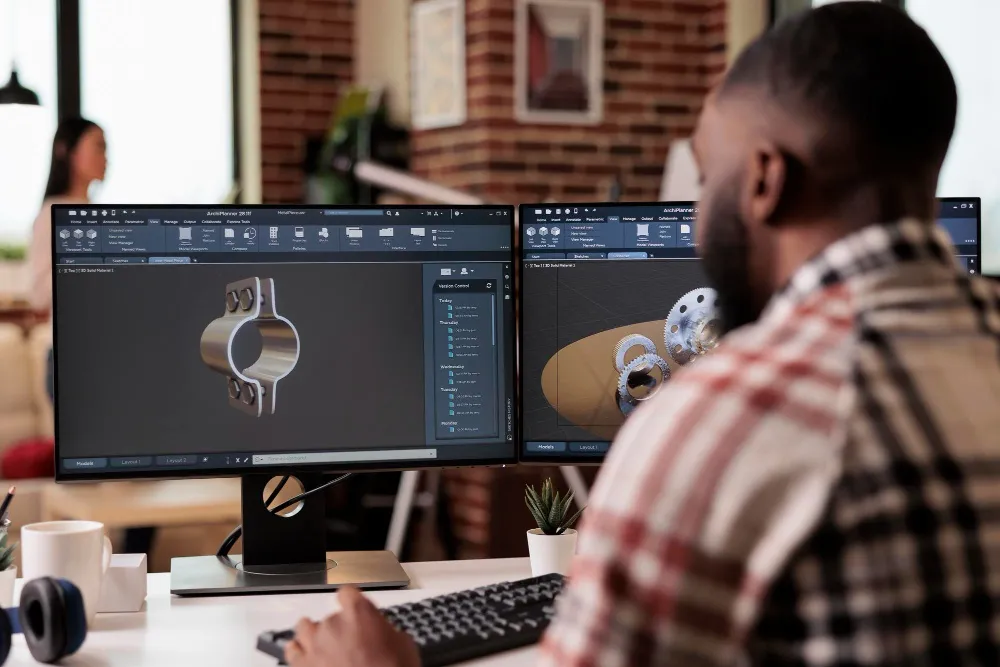Crafting Your Industrial Designer Cover Letter
An industrial designer cover letter is more than just a formality it’s your first impression. It’s your opportunity to showcase your skills, experience, and personality before the hiring manager even looks at your portfolio. A well-crafted cover letter grabs attention, highlights your unique value proposition, and encourages the reader to delve deeper into your application. This guide provides all the necessary information to craft a compelling cover letter and get you noticed by potential employers. Remember that the cover letter is an essential component for standing out and getting the job.
Understanding the Importance of a Cover Letter
In the competitive field of industrial design, a cover letter is a crucial document. It serves as a personal introduction and a chance to explain why you are the perfect fit for the role. Unlike your resume, which provides a snapshot of your experience, the cover letter lets you tell a story. It allows you to connect with the hiring manager on a more personal level, demonstrating your enthusiasm for the position and the company. It also provides an opportunity to explain any gaps in your employment history or career changes.
Highlighting Your Skills and Experience
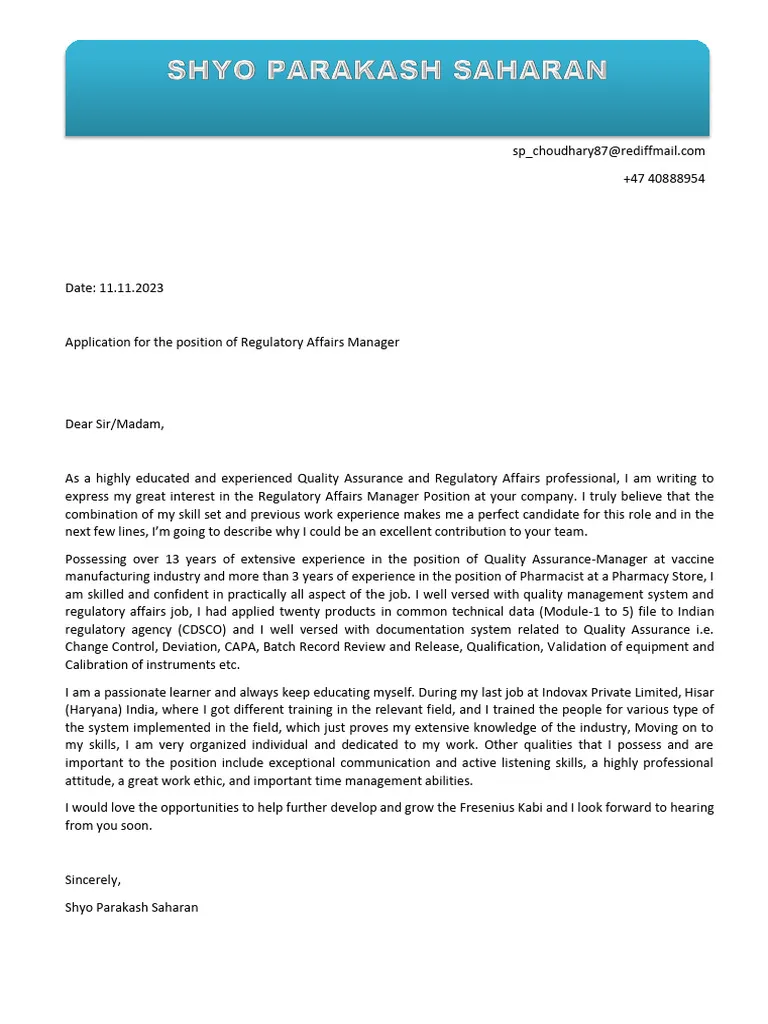
Your cover letter should immediately highlight your most relevant skills and experiences. Start by identifying the key requirements of the job description and then explain how your background aligns with those needs. Use specific examples to illustrate your accomplishments, quantifying your achievements whenever possible. For example, instead of saying ‘Improved product design,’ you could say ‘Increased product efficiency by 15% through design optimization.’ Always use strong action verbs to describe your contributions and responsibilities. Remember, the goal is to demonstrate how your skills will benefit the company.
Showcasing Your Design Portfolio
Your cover letter is the perfect place to hint at your portfolio. Mention key projects that are most relevant to the job you’re applying for. Briefly describe the project and highlight the skills you used. Ensure your portfolio is easily accessible, whether it’s a link to your website or a digital portfolio. Mention the portfolio link within the cover letter for easy access for the hiring manager. If you have a digital portfolio, be sure to include a link to it in your email signature as well. The portfolio is the most critical element of your application.
Tailoring Your Cover Letter to the Job
Generic cover letters are a major turn-off. Always customize your cover letter for each job application. Carefully read the job description and identify the key skills, qualifications, and responsibilities. Then, use your cover letter to demonstrate how your skills and experience match those specific requirements. This shows the hiring manager that you’ve taken the time to understand the role and are genuinely interested in the opportunity. Tailoring involves more than just changing the company name it means adjusting the content to emphasize the most relevant aspects of your background.
Researching the Company and its Culture
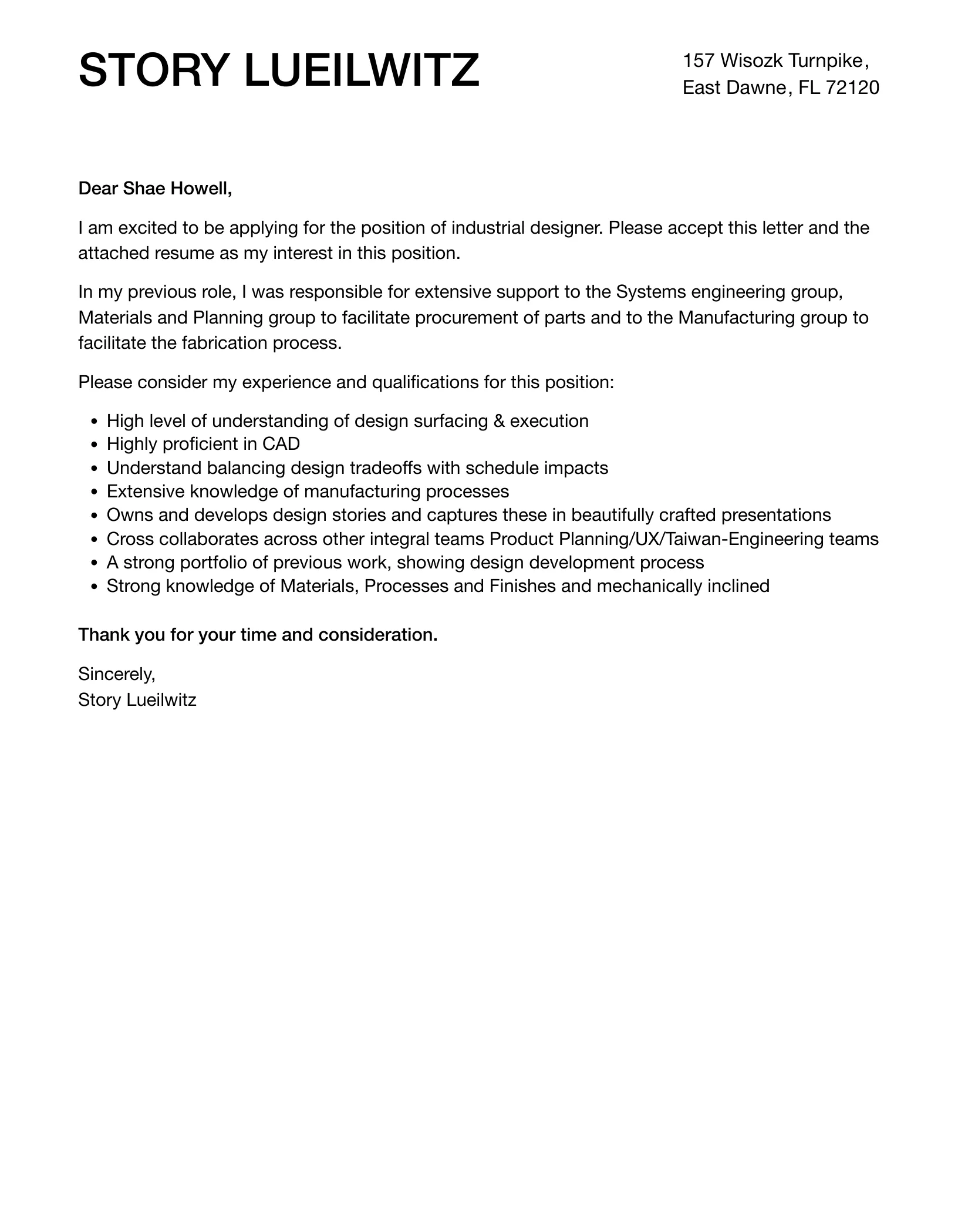
Before writing your cover letter, research the company. Learn about their products, their design philosophy, and their company culture. This research will allow you to tailor your cover letter to their specific needs and demonstrate your genuine interest in working for them. Mention specific projects or products that you admire and explain how your skills align with their goals. You can find this information on the company website, social media channels, and industry publications. Show that you are not just looking for a job but are passionate about their work.
Formatting Your Industrial Designer Cover Letter
Formatting your cover letter correctly is just as important as the content. Use a professional font, such as Arial or Times New Roman, and ensure your text is easy to read. Use clear headings and subheadings to organize your information and make it easier for the reader to scan. Keep the paragraphs concise, and use bullet points to highlight key skills and accomplishments. Your formatting should be clean, consistent, and visually appealing, reflecting your attention to detail. Aim for a layout that is both professional and easy on the eyes, and is about one page in length.
Structuring Your Cover Letter for Impact
A well-structured cover letter has a clear beginning, middle, and end. Start with a strong opening that grabs the reader’s attention. The body of your letter should highlight your relevant skills and experience and demonstrate your enthusiasm for the role and the company. Conclude with a call to action, expressing your interest in an interview and thanking the hiring manager for their time and consideration. Every section of the letter should have a clear purpose, and the structure should guide the reader through your key selling points.
The Opening Paragraph Grabbing Attention
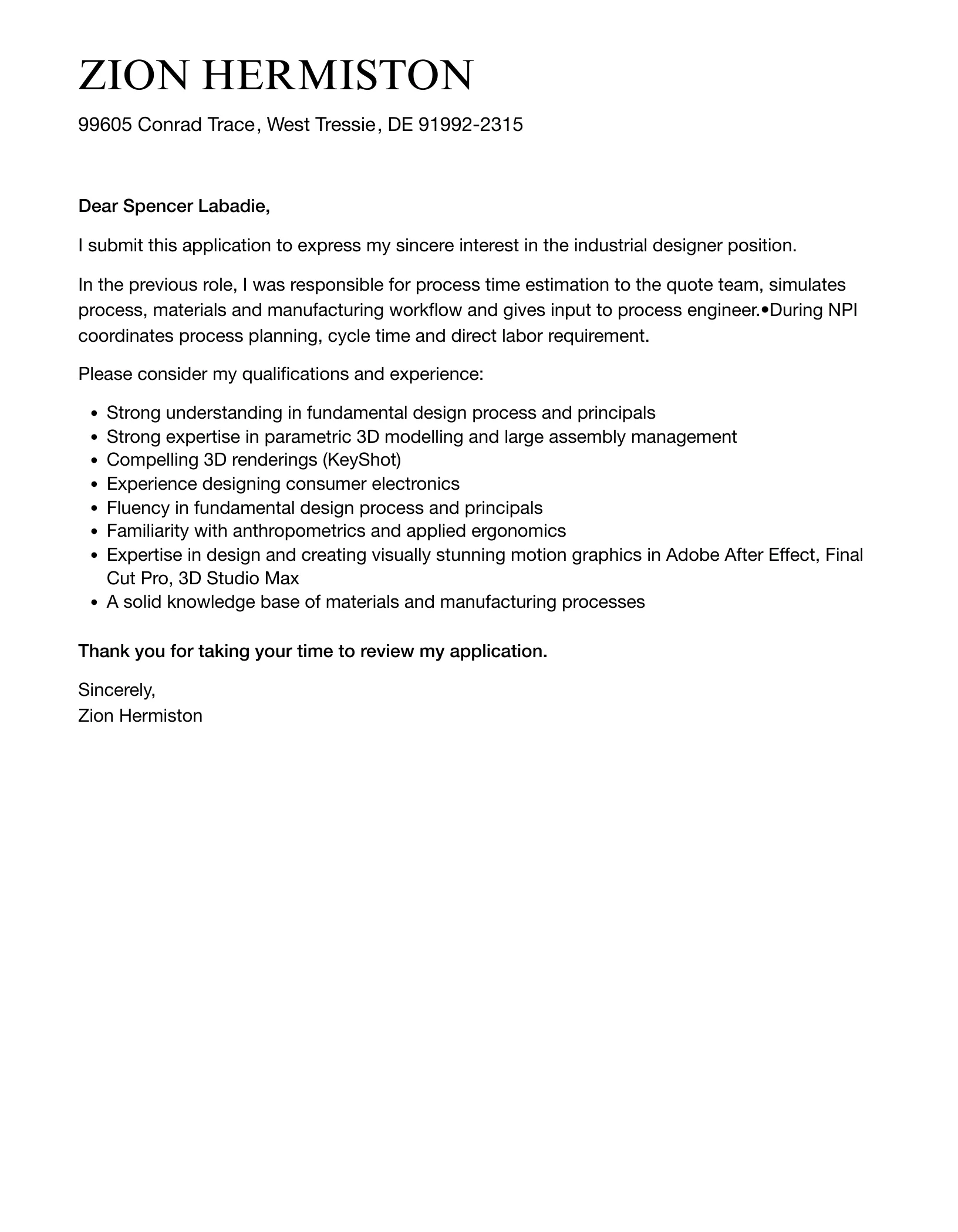
The opening paragraph is your chance to make a strong first impression. Avoid generic phrases such as ‘I am writing to express my interest.’ Instead, start with a compelling statement that showcases your enthusiasm and highlights your key qualification or a unique achievement. You can also mention how you learned about the opportunity or what attracted you to the company. Your goal is to capture the reader’s attention and make them want to read the rest of your letter. Make sure the tone matches the company culture.
Highlighting Relevant Skills & Accomplishments
The body of your cover letter should focus on your relevant skills and accomplishments. Use specific examples to demonstrate how you’ve used your skills to achieve results. Quantify your achievements whenever possible, using numbers and data to illustrate your impact. For instance, ‘Designed a new product that increased sales by 20%’ is more impactful than ‘Improved product design.’ Tailor this section to the specific requirements of the job description and emphasize the skills and experiences that align with their needs.
Demonstrating Your Passion for Design
Show your passion for industrial design. Share why you are passionate about design and the field. Mention your enthusiasm for the company’s products and design philosophy. You should show your excitement to be considered for this role. Demonstrate your understanding of current design trends and innovations. Your enthusiasm will go a long way towards making you stand out from other candidates.
Emphasizing Your Understanding of the Company
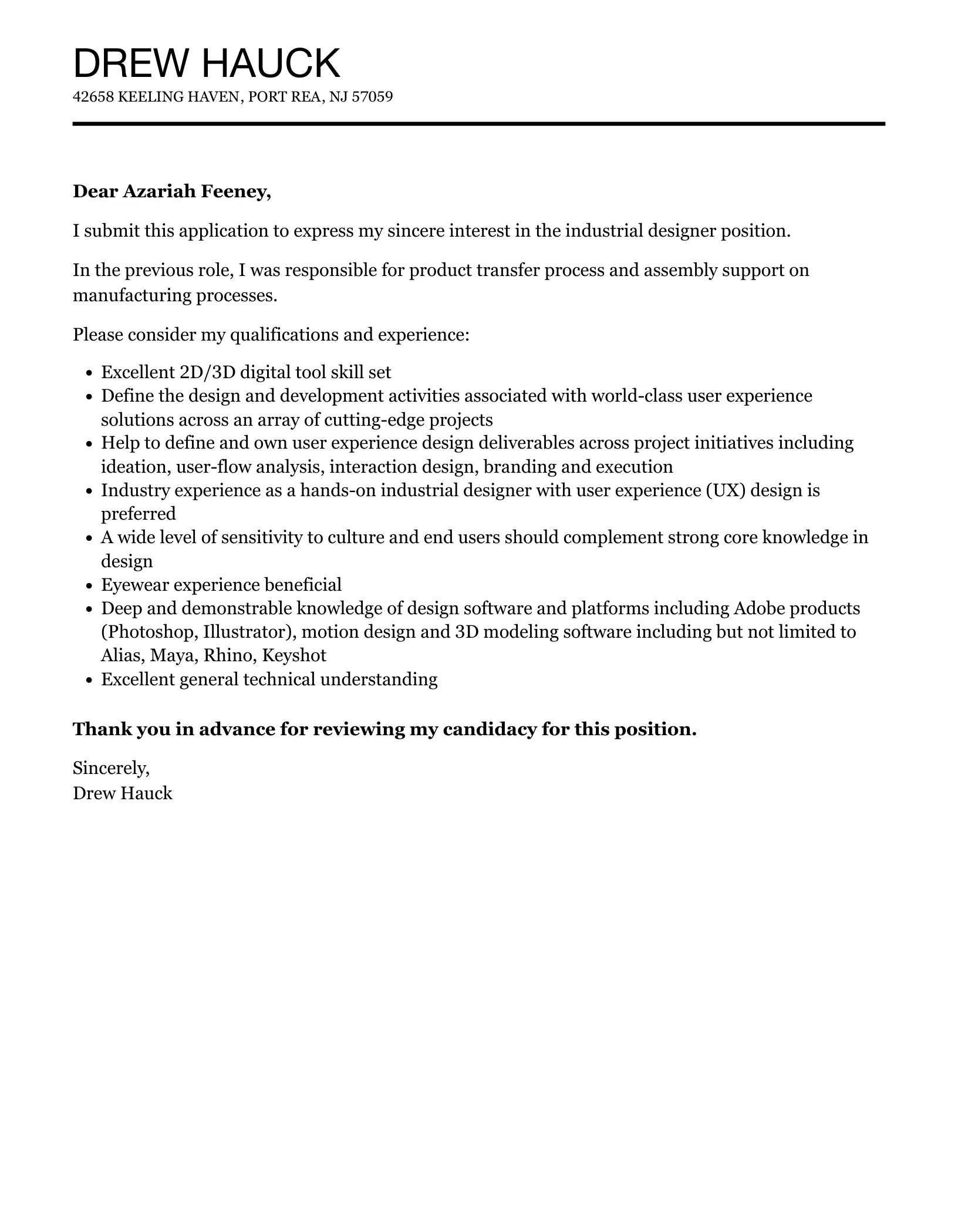
Show the company you’ve done your homework. Refer to the company’s mission statement or their recent projects, and explain how your skills and experience align with their values and goals. Mention any products you admire or have used, and explain why they resonate with you. This level of detail demonstrates your genuine interest in the company and helps you stand out. Your ability to connect with the company’s brand and culture can greatly boost your chances.
Key Skills to Include in Your Cover Letter
Identify the key skills needed for the job and make sure to emphasize them. Include both technical and soft skills. Technical skills like CAD software proficiency (SolidWorks, AutoCAD, etc.), prototyping, and manufacturing knowledge are essential. Soft skills like communication, problem-solving, and teamwork are equally important. Focus on the skills most relevant to the role, and give examples of how you’ve used those skills in the past.
Technical Skills for Industrial Designers
Technical skills are at the core of industrial design. Highlight your proficiency in CAD software (SolidWorks, AutoCAD, Rhino, etc.). Mention your expertise in 3D modeling, rendering, and prototyping. Showcase your knowledge of manufacturing processes (injection molding, CNC machining, etc.) and materials selection. Other skills may include user research, concept development, and design for manufacturability (DFM).
Soft Skills to Showcase
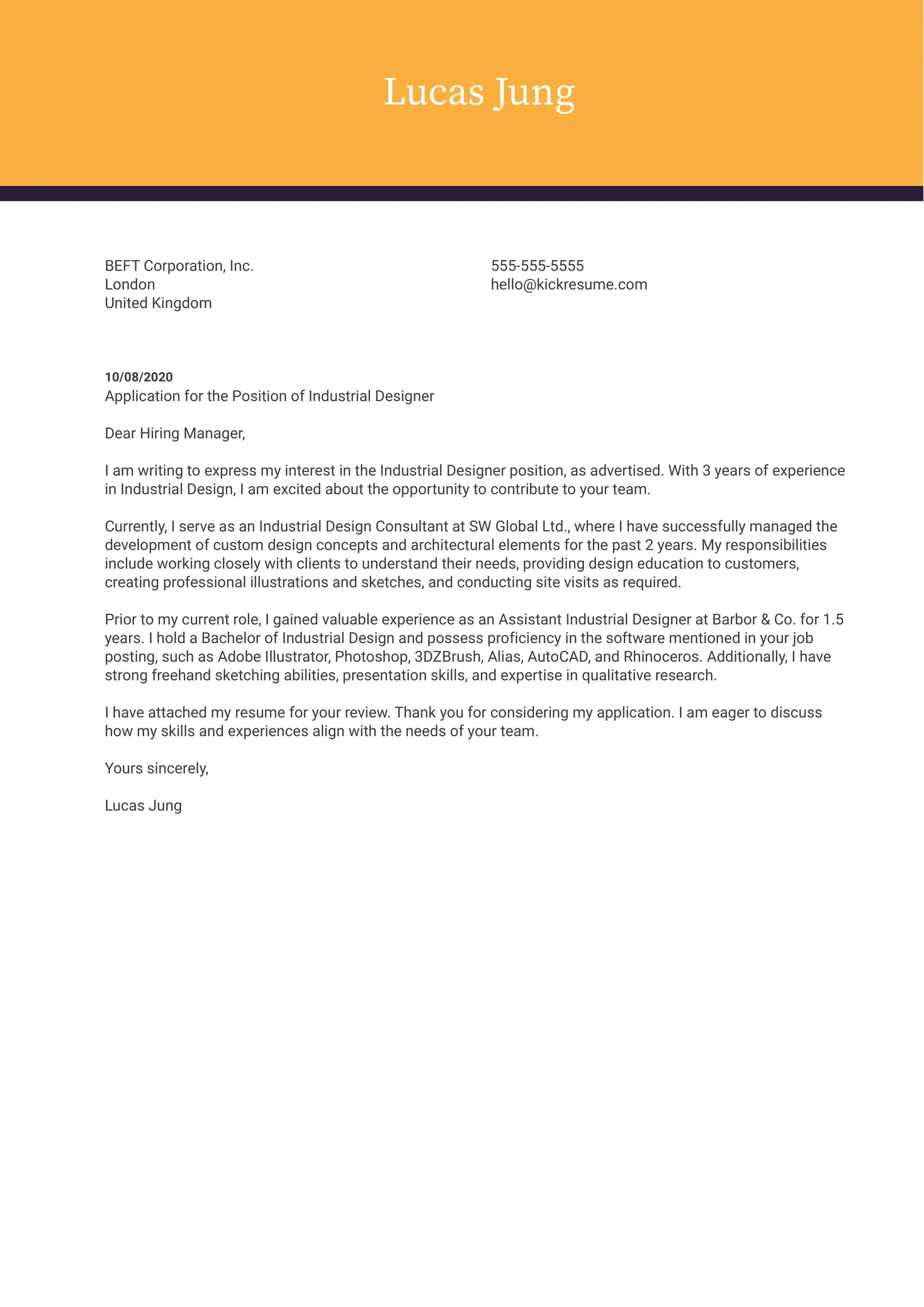
Soft skills are crucial for success in any design role. Highlight your communication skills, both written and verbal. Show your ability to collaborate with others, work in a team, and present your ideas effectively. Demonstrate your problem-solving skills, your ability to think creatively, and your attention to detail. Show your leadership skills by explaining your ability to lead projects and motivate teams. Be prepared to provide examples of how you’ve used these skills in past projects.
Portfolio Presentation Tips
Your portfolio is your most important marketing tool. Choose your best projects to showcase, focusing on those most relevant to the job you’re applying for. Present your work clearly and concisely, with high-quality images, detailed descriptions, and explanations of your design process. Make sure your portfolio is easy to navigate, with a clear structure and easy-to-find contact information. Keep it updated, and make sure that it is professional, well-organized, and reflects your personal style.
Selecting the Right Projects
Choose projects that showcase your diverse skills and experiences, as the role demands. Select projects that demonstrate your creativity, technical abilities, and design thinking. Show variety in your portfolio, including different product types and design styles. Prioritize projects that align with the job description and the company’s focus. Include a mix of personal and professional projects to showcase your versatility.
Presenting Your Work Effectively
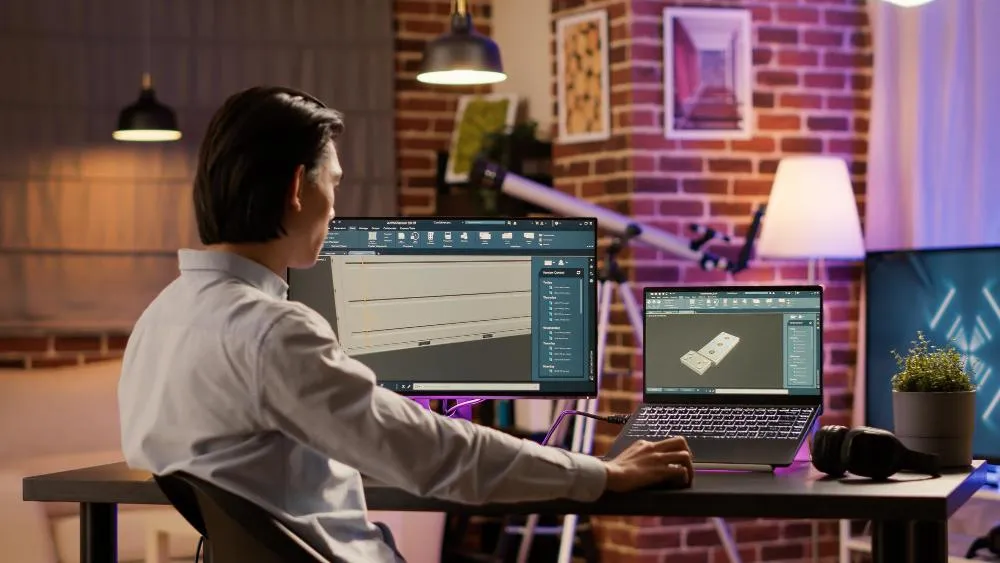
Present your work in a visually appealing and organized manner. Use high-quality images and clear descriptions. Explain your design process, including your research, concept development, and prototyping. Include relevant technical details, such as materials, dimensions, and manufacturing methods. Show your understanding of the design problem and your ability to create innovative solutions. Every project should have a clear narrative that tells the story of your design process.
Adapting Your Cover Letter for Different Roles
Tailor your cover letter to each specific job, as different roles require different skills and experiences. For a product design role, emphasize your sketching, 3D modeling, and prototyping skills. For a user experience (UX) design role, highlight your user research, usability testing, and interaction design skills. If you are applying for a management position, stress your leadership, project management, and communication skills. Customizing your cover letter for each job ensures that you address the specific requirements and demonstrate why you are the best fit.
Addressing Specific Job Requirements
Carefully review the job description and identify the key requirements. Use your cover letter to address each requirement, providing specific examples to show how you meet those needs. If the job requires experience with a specific software or process, make sure to highlight your proficiency. If the role involves managing a team, demonstrate your leadership skills and experience. Be sure to tailor your letter to the specific language and keywords used in the job posting.
Keywords and Phrases to Use
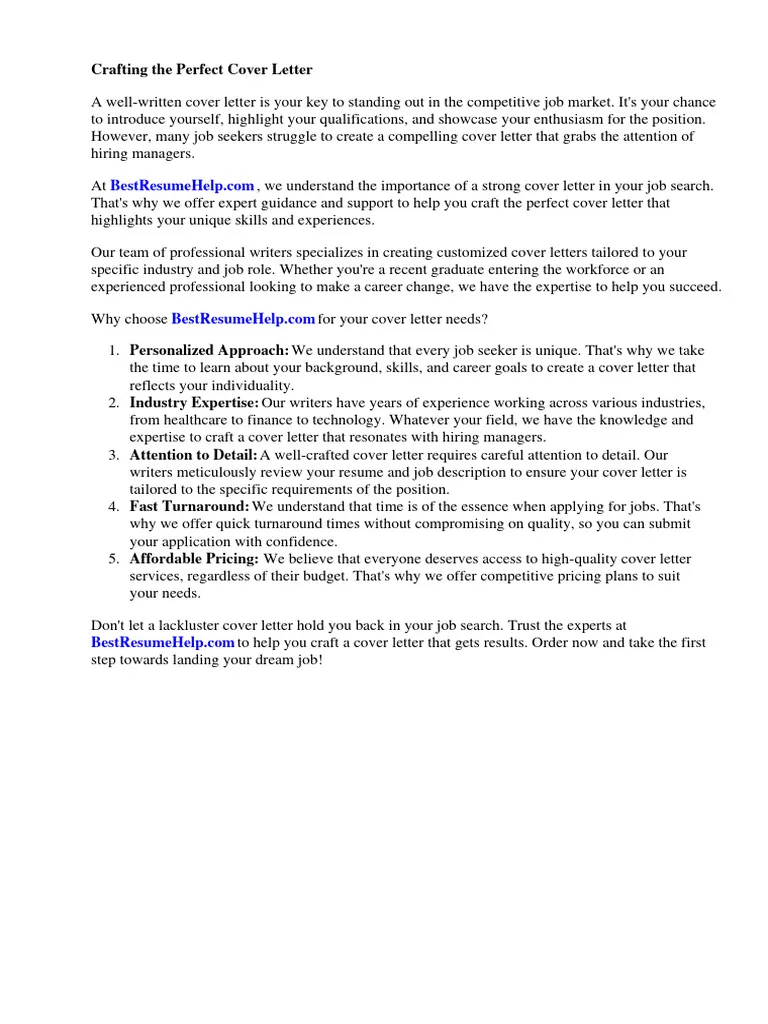
Use industry-specific keywords and phrases to demonstrate your knowledge and expertise. Incorporate words from the job description into your cover letter. Some examples of keywords include: CAD software, 3D modeling, prototyping, user research, design thinking, and project management. Use action verbs to describe your accomplishments, such as: designed, developed, created, managed, and implemented. Make sure the use of keywords feels natural and doesn’t make your letter sound like a list.
Common Mistakes to Avoid
Avoid common mistakes that can hurt your chances. Do not use generic cover letters, always customize your letter. Avoid grammatical errors and typos, proofread carefully. Do not use overly long paragraphs, keep your writing concise and to the point. Avoid negative language or complaining about past employers. Don’t oversell yourself; instead, let your accomplishments speak for themselves. Make sure that you have included a strong call to action.
Grammar and Spelling Errors
Grammar and spelling errors can make you appear unprofessional. Always proofread your cover letter carefully. Use a spell-checker and grammar-checker. Have someone else read your cover letter to catch any errors you might have missed. Double-check proper nouns and company names. A polished, error-free cover letter shows attention to detail and respect for the hiring manager.
Generic Cover Letters
Avoid using generic cover letters, which are a major red flag for hiring managers. Take the time to customize your cover letter for each job application. Show the company why you’re a good fit for their specific role. Be specific about why you are interested in this specific company. Personalize your letter by mentioning specific projects, products, or initiatives that interest you.
Ending Your Cover Letter with a Strong Call to Action
Conclude your cover letter with a clear call to action. Express your enthusiasm for the opportunity and reiterate your interest in an interview. Provide your contact information again, including your phone number and email address. Thank the hiring manager for their time and consideration. End with a professional closing such as ‘Sincerely’ or ‘Best regards’, followed by your name.
Thanking the Hiring Manager
Always thank the hiring manager for their time and consideration. This simple gesture shows respect and professionalism. Reiterate your interest in the position and your appreciation for the opportunity. Express your hope to hear from them soon.
Providing Contact Information
Make it easy for the hiring manager to contact you. Provide your phone number and email address. Include a link to your online portfolio. Ensure your contact information is correct and up-to-date. This shows your availability and eagerness to respond to any inquiries.
Proofreading Your Cover Letter
Proofread your cover letter carefully before submitting it. Check for grammar and spelling errors, and also for typos. Ensure your sentences are clear and concise. Have someone else review your letter to get a fresh perspective. A well-proofread cover letter shows attention to detail and makes a positive impression on the hiring manager.
